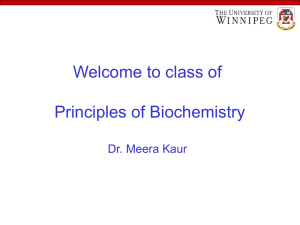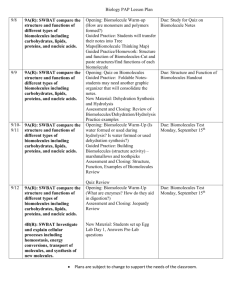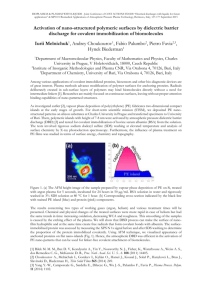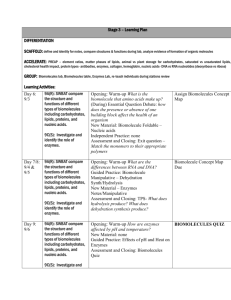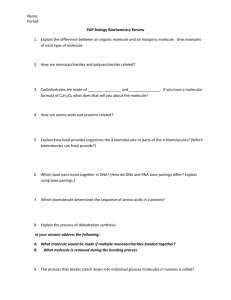Immobilization Principles - Selecting the Surface
advertisement
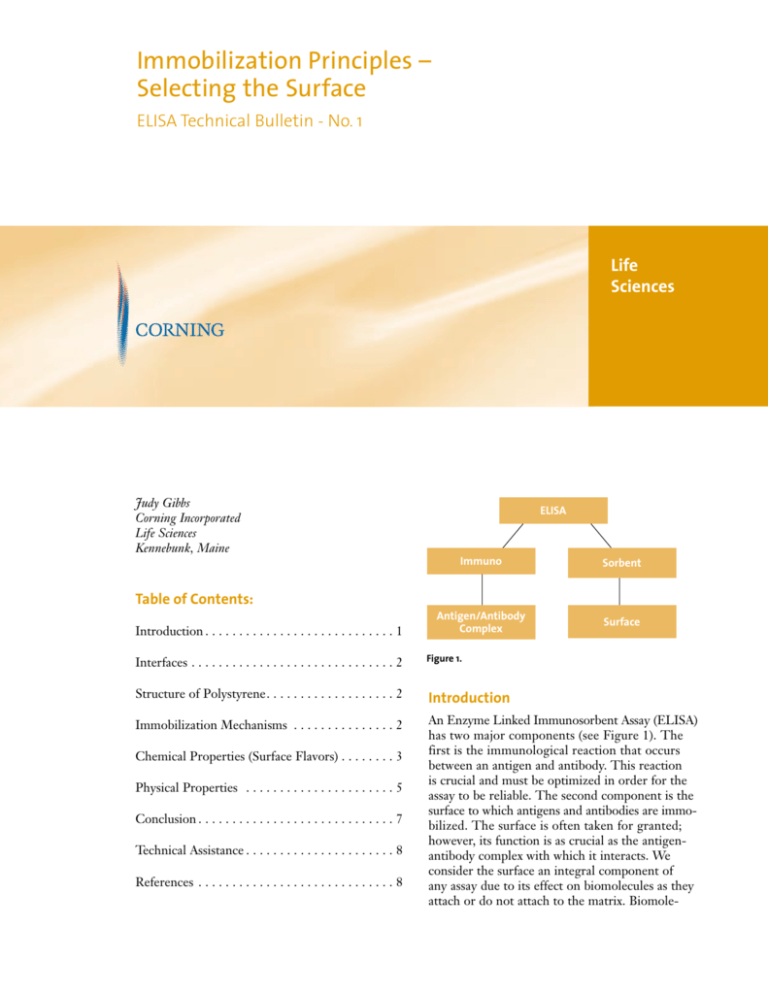
Immobilization Principles – Selecting the Surface ELISA Technical Bulletin - No. 1 Life Sciences Judy Gibbs Corning Incorporated Life Sciences Kennebunk, Maine ELISA Immuno Sorbent Antigen/Antibody Complex Surface Table of Contents: Introduction . . . . . . . . . . . . . . . . . . . . . . . . . . . . 1 Interfaces . . . . . . . . . . . . . . . . . . . . . . . . . . . . . . 2 Figure 1. Structure of Polystyrene. . . . . . . . . . . . . . . . . . . 2 Introduction Immobilization Mechanisms . . . . . . . . . . . . . . . 2 An Enzyme Linked Immunosorbent Assay (ELISA) has two major components (see Figure 1). The first is the immunological reaction that occurs between an antigen and antibody. This reaction is crucial and must be optimized in order for the assay to be reliable. The second component is the surface to which antigens and antibodies are immobilized. The surface is often taken for granted; however, its function is as crucial as the antigenantibody complex with which it interacts. We consider the surface an integral component of any assay due to its effect on biomolecules as they attach or do not attach to the matrix. Biomole- Chemical Properties (Surface Flavors) . . . . . . . . 3 Physical Properties . . . . . . . . . . . . . . . . . . . . . . 5 Conclusion . . . . . . . . . . . . . . . . . . . . . . . . . . . . . 7 Technical Assistance . . . . . . . . . . . . . . . . . . . . . . 8 References . . . . . . . . . . . . . . . . . . . . . . . . . . . . . 8 cules attach to surfaces via a variety of mechanisms. This attachment phenomenon is controlled by the chemical properties of the surface, but can be influenced by (i) the physical properties of the containment vessel (96 well plate) and (ii) other factors such as pH and temperature. In this, the first in a series of five ELISA technical bulletins, we will be primarily concerned with the surface and its interactions with biomolecules. Interfaces Proteins and other biomolecules denature at interfaces. During the course of an immunoassay, several interfaces are formed that affect the structure and function of the biological components. The initial interfaces to exist during a typical assay are formed between (i) the solid surface and the aqueous biological solution (SOLID-LIQUID) and (ii) the aqueous biological solution and air (LIQUIDGAS). Biomolecules located at either interface can and do denature. As the biomolecules attach to the solid surface, their conformation is altered depending on the chemical properties of the surface. In many instances, the molecules unfold to expose hydrophobic regions that interact with the surface in what is considered passive adsorption. H (C H H H H C )n C H C C C C C H H Figure 2. The Structure of Polystyrene 2 During the course of an ELISA, after protein or biomolecule immobilization to the surface is realized, non-bound reagents are removed from the surface, leaving a liquid film behind. The same SOLID-LIQUID-GAS interfaces exist; however, the denaturing effect on the immobilized biomolecules is intensified by the removal of the liquid phase. Many assays destined for storage for future use require that the immobilized biomolecules be dried to the surface. This drying step introduces a new set of interfaces — SOLID-DRY FILM-GAS — and increases the denaturing effect on biomolecules at the surface. At this point, biomolecules that were immobilized and active in a liquid environment may be so severely denatured that activity, immunological, enzymatic, etc., may be totally lost due to conformational (sometimes irreversible) changes. Severe denaturing can be alleviated by adhering to principles used with lyophilization procedures. Proteins attached to surfaces need to be protected and stabilized during any drying process. This protection can be accomplished by the addition of stabilizing reagents such as inert proteins, sucrose, glycerol and other compounds that structure water around the bound biomolecule. The most practical stabilizing reagent for proteins bound to surfaces and destined for further immunological reactions is an inert protein — usually the same inert protein used as the blocking reagent. For assays that require dry storage, the use of PBS (phosphate buffered saline) as the biomolecule diluent is recommended due to its ability to structure water around the surface-bound molecules. Other common diluents, such as carbonate buffers, do not have the same stabilizing effect as PBS. A more detailed discussion of recommended storage conditions that help reduce the negative effects of drying is presented in ELISA Technical Bulletin #2. In terms of surface selection, it is important to note that surfaces and their associated mechanisms of immobilization can and do play a role in the severity of denaturation problems that occur at SOLID-LIQUID interfaces. Structure of Polystyrene Polystyrene is a long carbon chain with pendant benzene rings on every other carbon (see Figure 2). Its structure makes it a very hydrophobic compound. This hydrophobicity is retained when polystyrene is molded into devices, such as 96 well plates. A non-treated polystyrene surface is by nature hydrophobic; however, polystyrene can be easily modified by radiation and other techniques that alter the chemistry of the surface. Essentially, the benzene ring, present at the surface, lends itself to chemical modification. Carboxyl and amine groups can readily be grafted to the surface. The polystyrene can also be modified through chemical reactions to allow the covalent attachment of a variety of reactive groups that can be used for the subsequent covalent immobilization of biomolecules. Immobilization Mechanisms Proteins and other biomolecules attach to surfaces by several different mechanisms. (Please refer to the Corning web-based Surface Selection Guide for additional information.) Passive adsorption consists of primarily hydrophobic interactions or hydrophobic/ionic interactions between the biomolecules and the surface. Typical nomenclature for passive binding surfaces includes Medium Binding for hydrophobic surfaces and High Binding for surfaces that are modified to have a small number of ionic carboxyl groups resulting in a slightly ionic, hydrophobic surface. Covalent immobilization to polystyrene can be accomplished through several means. On surfaces that are aminated or carboxylated, covalent coupling is achieved using bifunctional crosslinkers that couple the amine or carboxyl group on the surface to a functional group, such as an amine or sulfhydryl, on the biomolecule. Selection of the crosslinker determines the type of covalent bond that will be formed. Functional and covalently reactive groups, such as N-oxysuccinimide, maleimide and hydrazide groups, can also be grafted onto a polystyrene surface. These reactive groups are coupled to the polystyrene via a photolinkable spacer arm resulting in a stable, yet reactive surface. Surfaces that are hydrophilic and neutrally charged are considered low binding. Since proteins and other biomolecules passively adsorb to surfaces through hydrophobic and ionic interactions, a surface lacking these characteristics naturally inhibits nonspecific immobilization via these forces. Chemical Properties (Surface Flavors) Medium Binding Polystyrene As mentioned earlier, non-modified polystyrene surfaces are hydrophobic in nature and can only bind biomolecules through passive interactions. This type of surface is referred to as Medium Binding and is primarily suitable for the immobilization of large molecules, such as antibodies, that have large hydrophobic regions that 3 can interact with the surface. Due to the large surface area needed to immobilize biomolecules in this manner, binding capacities are typically low (100 to 200 ng IgG/cm2). Due to the single mechanism of attachment, Medium Binding surfaces are considered easy to block using either inert proteins or non-ionic detergents. Many assays employing the immobilization of non-purified antibodies or antigens (>20 kD) use this surface due to its ability to bind only the large, hydrophobic components in the mixture. This reduces the potential of cross-reactivity problems with smaller contaminants in the mixture. One drawback of hydrophobic immobilization is the denaturing effect it has on biomolecules as they unfold to expose hydrophobic regions that can interact with the surface. High Binding Polystyrene Polystyrene is easily modified to be what is considered High Binding via the use of radiation. The radiation effectively incorporates carboxylic acid on the accessible carbons of the “broken” benzene ring. The resulting surface is primarily hydrophobic with intermittent carboxyl groups capable of ionic interactions with positively charged groups on biomolecules. The mechanism of immobilization is passive adsorption through hydrophobic and ionic interactions. This is considered a general purpose surface capable of binding medium (>10 kD) and large biomolecules that possess ionic groups and/or hydrophobic regions. Binding capacity is increased as compared to the Medium Binding surface to approximately 400 to 500 ng IgG/cm2 because ionic interactions require that a smaller portion of the molecule be in contact with the surface to obtain stable immobilization. The negative effects of denaturation are still evident on this surface. There is also a concern that the antigenic (or active) site is part of, or adjacent to, the positively charged region of the molecule that interacts with the surface creating a possibility of a steric interference. This surface cannot be effectively blocked using a nonionic detergent alone; the addition of a protein blocking step is required. Aminated Polystyrene Polystyrene can also be modified to possess positively charged amine groups that replace the benzene ring at the surface. This type of surface lacks hydrophobic character and is strictly ionic in nature. Using the appropriate buffers and pH, this surface can be used to ionically couple to small negatively charged biomolecules. The lack of hydrophobic areas on the surface precludes the immobilization of large, relatively hydrophobic molecules. This surface was specifically designed to be used with bifunctional crosslinkers (i.e., glutaraldehyde, carbodiimide) to covalently couple to functional groups (primary amines, thiols, carboxyls) on biomolecules. Due to its hydrophilic nature and capability of covalent immobilization through the use of additional crosslinkers, this surface can be used to immobilize molecules solubilized in detergents, such as Triton X-100 and Tween 20 (see Table 1 and Figure 3). A negative aspect of the amine surface is the stringency needed to effectively block the surface. Due to its hydrophilic/covalent surface characteristics, blocking reagent used with this surface must be able to interact with non-reacted amine groups, as well as with any functional groups (succinimide, aldehyde, maleimide) exhibited by the chosen crosslinker. Tissue Culture Treated Polystyrene Polystyrene surfaces that are primarily hydrophilic and negatively charged (carboxyl groups) are designed for cell attachment. Under typical assay conditions, this type of surface will act as an ion exchange matrix, allowing molecules with greater ionic potential (surface affinity) to replace previously immobilized molecules with lesser affinity for the surface. Non-specific background tends to be difficult to control. We advise that surfaces specified as Tissue Culture Treated not be used for ELISA or similar procedures. Preactivated Covalent Surfaces Polystyrene can be modified via a variety of methods to possess functional groups Table 1. Covalent vs. Adsorbed Adsorbed/ Medium Adsorbed/ High Covalent/ Amine OD No Triton X-100 1.403 1.400 1.693 OD with Triton X-100 0.000 0.074 1.378 % Bound 0.0% 5.0% 81.0% Adsorption- high binding 3590 Covalent - Amine surface + 0.1% glutaraldehyde Mouse IgG (0.5 µg/mL) immobilized for 1 hour Blocking reagent -1% non fat dry milk Conjugate - HRP-GAM IgG Substrate - ABTS Adsorption Covalent Optical Density 1.0 0.5 0 0% 0.01% 0.05% 0.10% Tween 20 Concentration Figure 3. Effect of Detergent Concentration On Immobilization of IgG 4 0.30% designed to covalently immobilize biomolecules. Using a proprietary process, Corning has developed four such surfaces. All four surface “flavors” consist of functional groups that are covalently attached to the polystyrene via a photolinkable spacer arm. The four surfaces that are currently available are: ◗ ◗ ◗ ◗ Half Area A/2 5.0 mm 10.7 mm 4.5 mm Full Area 6.9 mm 10.7 mm 6.4 mm Figure 4. Well Size 5 N-oxysuccinimide (DNA-BIND™) — to couple to amine groups Maleimide (Sulfhydryl-BIND™) — to couple to free sulfhydryl groups Hydrazide (Carbo-BIND™) — to couple to periodate activated carbohydrate moieties Universal-BIND™ — to non-specifically couple through abstractable hydrogen via UV activation Since the first three of these surfaces are highly specific for their coupling partner (amine, sulfhydryl, or activated carbohydrate), they are used to immobilize biomolecules in a site-directed manner. The Universal-BIND surface is specific for abstractable hydrogen, but this is not in a site-directed manner. The size of the biomolecule is irrelevant; single amino acids can be immobilized to the correct surface “flavor.” Since the immobilized biomolecules are attached via a single point, denaturation effects are minimized, but not eliminated. The effects caused by excessive drying and the lack of stabilizing reagents are still evident. Choosing the appropriate surface requires that the structure of the molecule to be immobilized be known, such that functional groups available on the molecule are matched with the correct surface. Of particular concern is that the functional group on the biomolecule that will be interacting with the surface must be positioned in such a manner that immobilization does not interfere with the activity (immunological or enzymatic). Blocking of these surfaces requires that the blocking solution contain a reagent that possesses the appropriate functional group as well as components capable of blocking hydrophobic sites along the spacer arm. Non-Binding Surfaces Certain procedures require a surface that is non binding. Many proteins, enzymes in particular, may become activated or inactivated upon attachment to a surface. A non-binding surface can be ideal for assays requiring this feature. Physical Properties Assays can be performed in a variety of vessels from tubes to plates. One of the most versatile formats is the 96 well plate, which is offered with the selection of surface “flavors” discussed in the previous section. As the surfaces of these plates can vary, so can their physical properties. And, as the surface plays an important and crucial role in biomolecule immobilization and assay design, the physical properties can also affect assay performance. The physical properties that affect assay performance the most are (i) well size, (ii) well shape, and (iii) plate pigment. Well Size The 96 well plates are available with two well sizes — full size and half area (half volume). Full size wells are typically used for immunoassays. Total well volume is approximately 300 µL. The surface area covered by 100 µL of solution is approximately 1.0cm2. This plate well size is compatible with all commercially available 96 well plate devices, such as automated washers and readers. However, Corning offers the half area well plate, having a total volume of approximately 150 µL with a working volume of 50 µL, as an alternative. Most assays can be and are performed in full size (standard) 96 well plates. However, there are instances when a smaller well can be beneficial: ◗ ◗ limited supply of reagent and high cost of reagents. Because of the surface-to-volume ratio and the diffusion distance associated with a smaller size well, assay volumes can be reduced by 1/2 without affecting the sensitivity of the assay. Since the half area well is approximately half the diameter Surface Selection Chart Flat Round Easy Wash™ Surface Binding Interaction Sample Properties Medium Binding Hydrophobic Large biomolecules >20kD with large or abundant hydrophobic regions High Binding Hydrophobic and ionic Medium-large biomolecules >10kD that are positively charged +/- hydrophobic regions Aminated-Polystyrene Ionic or covalent via bifunctional crosslinkers Small negatively charged biomolecules OR biomolecules possessing an appropriate functional group, such as amine, carboxyl or thiol N-oxysuccinimide (DNA-BIND™) Covalent Biomolecules possessing an available amine group Maleimide (Sulfylhydryl-BIND™) Covalent Biomolecules possessing an accessible sulfhydryl group or reducible disulfide bond Hydrazide (Carbo-BIND™) Covalent Biomolecules possessing carbohydrate moieties available for periodate activation Universal-BIND™ Covalent via UV crosslinking Biomolecules with abstractable hydrogen Non-Binding None - inhibits hydrophobic and ionic interactions Non-specific of a full size well, the diffusion time for molecules in solution (center) to reach the surface is reduced by 1/3. This decreased distance leads to an increased adsorption rate on the surface as depleted molecules are replaced faster. This means that assay time and/or assay volume can, in many cases, be reduced by 1/2 to 1/3 that required for assays performed in standard size wells. Using a volume of 50 µL in a half area well allows for a more favorable surface-to-volume ratio (1:75) as compared to the ratio (1:100) obtained when 100 µL is used in a standard size well. This favorable ratio, combined with the reduced diameter of the well (travel distance), allows for reduced volume without compromising sensitivity. These half area plates are unique and can be valuable for assays requiring smaller volume due to reagent availability or cost. However, because of the reduced diameter of the well, they are not compatible with all plate washers on the market and may need to be washed manually. and “eased” edge bottom (referred to as Easy Wash™) wells. Immobilization of biomolecules in general is not affected by well shape; however, assays may be designed to better accommodate one well shape versus another. Flat bottom wells are the most traditional well shape. They offer the advantage of being compatible with all microplate devices, such as washers and readers. The flatness feature allows for excellent optical transmission and low background adsorbance. The fact that this well shape retains a slight amount of fluid (approximately 5 to 10 µL) can be beneficial when the bound molecule is extremely susceptible to the negative effect of excessive drying. However, this retained volume of fluid can be easily tapped out of the well if required. Round bottom wells have been traditionally used as substitutes for test tubes. This shape allows for: ◗ Figure 5. Well Shapes Well Shape Plates and strips designed for assays are available with several well shapes including traditional flat bottom, round bottom 6 ◗ the elimination of surface related steric hindrance associated with large molecules bound in corners, and efficient removal of fluid, which is an advantage for assays employing the use of reagents that are negatively affected by residual wash solution. This shape, however, does not have the excellent optical characteristics of a flat bottom well. It is also mandatory that plate washers be adjusted to accommodate the round shape. This well shape is not recommended for use with biomolecules that are sensitive to the denaturing effects of excessive drying. The third well shape is a hybrid of the first two (flat and round). The bottom edges of this hybrid are tapered such that the sharp corner associated with a flat bottom well is eliminated and fluid hang up is minimized. Testing has shown that this design does allow for a minimal retention of fluid such that the negative effects of excessive drying are not as prominent as with the round bottom design. Since the actual optical surface of the well is flat, transmission and background are comparable to that obtained with flat bottom wells. Again, the shape of the well does not affect biomolecule immobilization, but can affect one’s assay technique. the opaque qualities of the solid black and white plates while allowing: ◗ ◗ ◗ Conclusion Selecting the right surface for immobilizing biomolecules is crucial to the development of accurate, precise, and sensitive bioassays. Since the surface plays an indispensable role in the reactions that take place at its interface with the biological components of the assay, one must choose a surface that: ◗ ◗ Pigment: Clear versus Opaque Plates The choice of pigment is a very straightforward decision. Clear plates made from pure polystyrene offer the most well defined binding characteristics and are ideal for colorimetric assays. However, for fluorescent and chemiluminescent assays, an opaque plate offers several advantages. Solid black plates and strips are typically used when fluorometry is the detection method. Opaque black plates reduce background due to autofluorescence, reduce well-to-well crosstalk and enhance sensitivity by reducing “light scatter.” For assays designed to quantify light emission from bioluminescent or chemiluminescent assays, a solid opaque white plate is advantageous. The white material chosen by Corning has a low luminescent background and no well-to-well crosstalk. Opaque white plates and strips can actually enhance assay sensitivity by reflecting light emitted from flash and glow chemiluminescent reactions. For procedures requiring optically clear wells — cell based assays, in particular — black and/or white plates with clear well bottoms are ideal. These plates combine 7 cell observation through clear wells, top and/or bottom options for signal detection, and dual labeling options utilizing colorimetric and fluorescent/ chemiluminescent detection in a single plate. ◗ forms a stable linkage with the bound molecules, immobilizes the molecules in such a manner that orientation and conformation result in optimal biomolecular activity, and does not interfere with biological reactions subsequent to the immobilization step. In choosing a surface and assay format, one must consider the chemical properties of the biomolecule being immobilized and match them to the chemical properties of the surface. A surface that is attractive to a large hydrophobic biomolecule may not be appropriate for a small negatively charged one. Many non-proteinaceous molecules cannot passively adsorb to a surface and require a covalent method of immobilization. Choosing the correct surface does not have to be a trial-and-error event if the binding interactions that can possibly take place between the biomolecule and the surface are carefully analyzed. Once an appropriate surface is selected, the next decision relates to the physical properties of the assay vessel. Care must be taken to choose a well size and shape that fits the assay technique being employed. Most automated assays require full size wells that can be utilized with standard assay equipment; whereas a manual assay designed around the use of rare, expensive reagents can be performed on half area wells to conserve valuable compounds. Plate formats, such as 384 well and 1536 well, further expand the choice of well size and shape. The choice of well shape is often a personal preference. However, if the molecule being immobilized to the surface is highly sensitive to residual wash solutions, a round bottom well should be used; whereas a flat bottom well should be used for biomolecules that cannot survive the denaturing effect of drying. Choosing clear or pigmented plates is fairly simple — clear for colorimetric detection, black for most (but not all) fluorometric detection and white for luminescent detection. Solid opaque plates can be used with solution based assays; however, fluorescent or luminescent cell-based assays require clear bottom black or white plates. The choices (surfaces and formats) for bioassays are many, but with careful consideration, a 96 well plate that possesses all the necessary characteristics for an optimized assay can be found. In future bulletins, we will be presenting information on methods that have been proven to improve assay results. Technical Assistance For additional ELISA technical support and bulletins, or product information, please visit the Corning Life Sciences website at www.corning.com/lifesciences or call 1-800-492-1110. References 1. Brash, J. L. and Horbett, T. A., editors. Proteins at Interfaces. ACS Symposium Series, 343; American Chemical Society, Washington, DC, 1987. 2. Craig, J.C. et. al. Journal of Biological Standardization. 17; 1989; 125-135. 3. Engvall, E. and Perlmann, P. Immunochemistry. 8:871; 1971. 4. Gardas, A. and Lewartowska, A. Journal of Immunological Methods. 106; 1988; 251255. 5. Graves, H.C.B. Journal of Immunological Methods. 111; 1988; 157-166. 6. Maggio, E.T. Enzyme Immunoassay. CRC Press, Inc., Boca Raton, Florida, 1980. 7. Ratner, B.D., editor. Surface Characterization of Biomaterials. Progress in Biomedical Engineering, 6; Elsevier Science Publishers B.V., The Netherlands, 1987. 8. Spitznagel, T.M. and Clark, D.S. Bio/Technology. 11; July 1993; 825-829. 9. Stenberg, M. and Nygren, H. Journal for Immunological Methods. 113; 1988; 3-15. Revised 7/01 Corning Incorporated Life Sciences 8 45 Nagog Park Acton, MA 01720 t 1.800.492.1110 f 1.978.635.2476 www.corning.com/lifesciences Carbo-BIND, DNA-BIND, Easy-Wash, Sulfhydryl-BIND and Universal-BIND are trademarks of Corning Incorporated, Corning, New York. Corning is a registered trademark of Corning Incorporated, Corning, New York. Corning Incorporated, One Riverfront Plaza, Corning, NY 14831-0001
